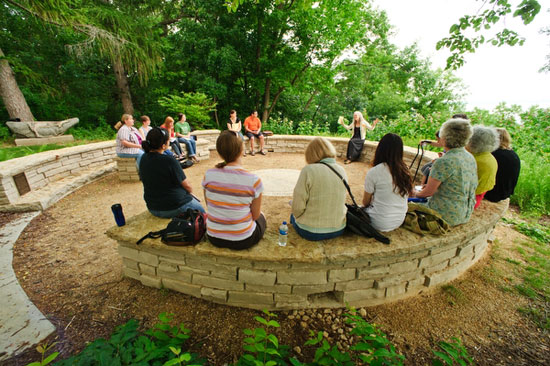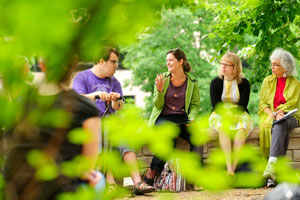Class continues Muir Knoll storytelling legacy

On July 13, 2011, students take part in a summer Storytelling and Oral Tradition class session taught by Anne Lundin (center), emeritus professor of library and information studies, held at the Robert E. Gard Storyteller’s Circle at Muir Knoll on campus.
Photos: Bryce Richter
Anne Lundin is carrying on a tradition at an idyllic campus spot steeped in storytelling history.
Lundin, a professor emerita, is teaching a summer class, “Storytelling and the Oral Tradition.” The class focuses on the oral tradition in world literature for children and often meets outdoors at Muir Knoll, a grassy area on the brow of Bascom Hill overlooking Lake Mendota.
Muir Knoll — named for former UW–Madison student and famed conservationists John Muir — was recently restored to its great tradition of being a place to share stories.
Through a generous gift of the Robert E. Gard Foundation, Muir Knoll’s centerpiece, Storyteller’s Circle, was revived as a gathering spot for Wisconsin’s innovative writers and storytellers.

“The storytelling circle offers us a concrete connection to the oral traditions and storied lives who have come before us”
Anne Lundin
“The storytelling circle offers us a concrete connection to the oral traditions and storied lives who have come before us,” says Lundin. “The inspiration of John Muir and Robert E. Gard stretches our boundaries and ideals … here they stood, and we can still hear the call of their stories.”
Gard, a former faculty member who died in 1992, was known as a great storyteller. He authored numerous books, many that focused on Wisconsin life and culture such as “Coming Home to Wisconsin,” “Down in the Valleys: Wisconsin Back Country Lore and Humor” and “My Land, My Wisconsin: The Epic Story of the Wisconsin Farm and Farm Family from Settlement Days to the Present.”
In 2003, an archaeological survey confirmed that Muir Knoll is also an ancient site. Researchers recovered chert flakes, the rock waste left behind from crafting a tool or possibly a spear point.
In the 1910s, the knoll served as an open-air theater. At this time, the area was named Storyteller’s Hill given that it served as the gathering place for Charles E. Brown’s summer “Folklore” meetings. Brown was a leading archaeologist and the State Historical Society’s museum director. In the summertime at UW, students would gather to hear his stories about local Native Americans and the early European-American settlers.
Though she retired three years ago, Lundin is teaching again this summer because she appreciates helping to create and maintain a storytelling community.
“I feel honored to be part of this human communication,” she says. “[Storytelling] is a context enriched by sound, images, and emotion.”
Ellen Bunn is delighted to be a part of Lundin’s class, which is offered through the School of Library and Information Studies and is one of about 1,500 courses offered campuswide each summer.
“I am inspired by her insights into the human emotions involved in oral storytelling,” she says. “What a meaningful and memorable way to grow as students embracing the world’s oral and written stories.”
With her warm and gentle manner, Lundin creates an open and trusting environment for students to explore their own voices as tellers of personal and folk stories, Bunn says.
